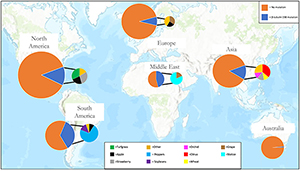The use of fungicides to treat plant pathogens dates back 150 years, when a mixture of lime and copper sulfate, known as the “Bordeaux mixture,” was used to control fungal diseases in French vineyards. However, as fungicide usage has increased, their efficacy has decreased thanks to a phenomenon known as fungicide resistance.
A new paper in Phytopathology offers an analysis of fungicide resistance, one that came out of COVID-19 shelter-in-place orders. “With the onset of COVID-19, we were brainstorming ways to be productive while not being able to work in the lab,” explained Michael Bradshaw, a plant pathologist with the USDA. “I’m proud that this was the research we came with.”

Bradshaw and colleagues mined genetic data from postharvest pathogens to infer how quickly fungicide resistance develops and analyze the impact of fungicide use.
“What was really interesting is that we noticed a decline in fungicide-resistant pathogens five to ten years after a lag in fungicide usage,” Bradshaw said. “For example, fungicide resistant pathogens peaked between 2005 and 2009, which is five to ten years behind the peak of FRAC 1 fungicide applications.”
Their research also evaluates the global distribution of fungicide-resistant pathogens and determined that host plant, pathogen locality, and pathogen genus are also associated with resistance to certain types of fungicides.
“This study was originally conducted as a resource for countries and farmers reliant on fungicides to control postharvest pathogens,” said Bradshaw. “The compiled data highlights regions and hosts that are most prone to certain resistant pathogens and inform fungicide resistance management strategies.”
Also of note, Bradshaw and his colleagues hypothesize that FRAC1 fungicide-resistant pathogens are less likely to survive in nature when this class of fungicide is not applied, which is contrary to lab-based findings. Future research can evaluate this hypothesis in the field to evaluate FRAC1 class fitness penalties.
